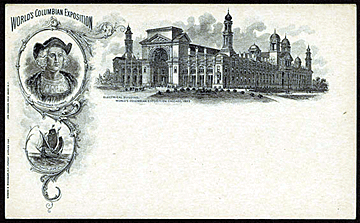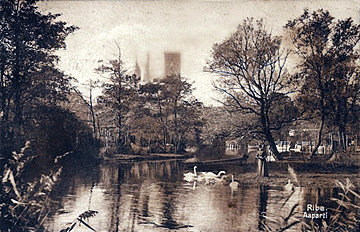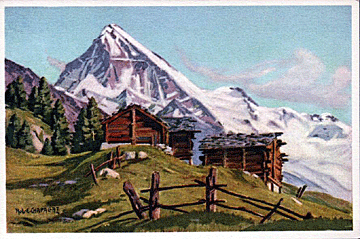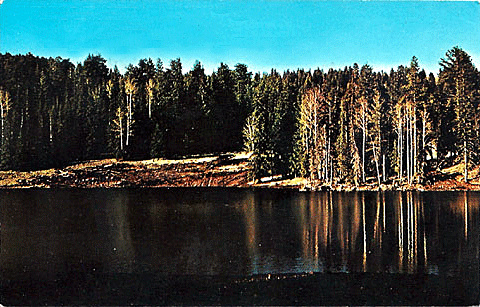|
Wish You Were Here?
by Bob Brooke
 “Having
a wonderful time. Wish you were here.” Before Email and Facebook, this
brief message scribbled on the back of a postcard said it all. It told
the folks back home that a traveler was okay and enjoying his or her
vacation. The picture on the front of the card showed the folks where
the person was and the postmark confirmed this. “Having
a wonderful time. Wish you were here.” Before Email and Facebook, this
brief message scribbled on the back of a postcard said it all. It told
the folks back home that a traveler was okay and enjoying his or her
vacation. The picture on the front of the card showed the folks where
the person was and the postmark confirmed this.
Sending picture post cards to the folks back home became a great
American pastime. When choosing cards to send, travelers also bought
many for themselves to save as souvenirs of their trips. Now many
millions of these vacation mementos lie in attics, waiting to be
rediscovered. Travelers usually took good care of the postcards they
gathered on their trips, preserving lovingly in albums to share with
friends. Many people collected postcards instead of lugging along a
camera to take their own pictures.
Today, these postcards of a bygone age are coming out of attics as older
people downsize. They can be found at garage sales, flea markets,
antique shops, and stamp shows.
The Origin of the Postcard
 The British produced the first postcard in 1870, and the
excitement was so great that the police had to be called out to control
the crowds at the London General Post Office. Two million
postcards sold in the first week, each costing a half penny. That same
year, postcards came to Germany, Luxembourg, and Switzerland, and by
1874 were available in most of the rest of the world. Cards showing the
Eiffel Tower in 1889 & 1890 gave impetus to the postcard craze a decade
later. Collectors consider a Heligoland card of 1889 the first
multi-colored card ever printed. The British produced the first postcard in 1870, and the
excitement was so great that the police had to be called out to control
the crowds at the London General Post Office. Two million
postcards sold in the first week, each costing a half penny. That same
year, postcards came to Germany, Luxembourg, and Switzerland, and by
1874 were available in most of the rest of the world. Cards showing the
Eiffel Tower in 1889 & 1890 gave impetus to the postcard craze a decade
later. Collectors consider a Heligoland card of 1889 the first
multi-colored card ever printed.
 Historians
recognize Baron Raphael Tuck, an English book printer, as the inventor
of the picture postcard in 1884. One day, it occurred to Tuck that a
postcard, provided with a view of a landscape or a foreign town would
say much more to the recipient than lengthy writing. Travelers came to
consider these early view cards as attractive souvenirs. People sent
picture postcards from various trips, whether domestic or foreign,
pleasure or business, indeed from every outing, walking, bicycling or
whatever. Historians
recognize Baron Raphael Tuck, an English book printer, as the inventor
of the picture postcard in 1884. One day, it occurred to Tuck that a
postcard, provided with a view of a landscape or a foreign town would
say much more to the recipient than lengthy writing. Travelers came to
consider these early view cards as attractive souvenirs. People sent
picture postcards from various trips, whether domestic or foreign,
pleasure or business, indeed from every outing, walking, bicycling or
whatever.
 But
it wasn’t until the Columbian Exposition in Chicago in 1893 that the
first souvenir postcard appeared. Colored artwork associated with the
fair appeared on the backs, then the non-address side, of
government-printed cards. These postcards, commonly known as “souvenir”
cards, became immensely popular. People who attended the fair sent
thousands of souvenir cards to friends back home. But when the Columbian
Exposition closed, the U.S. Government stopped issuing illustrated
postcards. Private publishers continued printing scenic views of tourist
locations, so these cards became known as “view” cards. But
it wasn’t until the Columbian Exposition in Chicago in 1893 that the
first souvenir postcard appeared. Colored artwork associated with the
fair appeared on the backs, then the non-address side, of
government-printed cards. These postcards, commonly known as “souvenir”
cards, became immensely popular. People who attended the fair sent
thousands of souvenir cards to friends back home. But when the Columbian
Exposition closed, the U.S. Government stopped issuing illustrated
postcards. Private publishers continued printing scenic views of tourist
locations, so these cards became known as “view” cards.
 Picture
postcards hit their peak of popularity from 1900 to 1918. They became a
form of entertainment, almost a mania, and a social phenomenon. By that
time, the total of postcards in the U.S. had reached over 968,000,000.
People put them into albums and set collections out to be admired. In
doctors offices, they became prestige symbols. Picture
postcards hit their peak of popularity from 1900 to 1918. They became a
form of entertainment, almost a mania, and a social phenomenon. By that
time, the total of postcards in the U.S. had reached over 968,000,000.
People put them into albums and set collections out to be admired. In
doctors offices, they became prestige symbols.
It was a fashion in high society for a family to assemble an exhibition
album, where they placed their best picture postcards on view in their
parlor. People also exchanged picture postcards which they purchased at
tobacco shops, stationers, and railroad stations.

World War I signaled the end of the golden age of postcards because of
the shortage of paper materials and because most of the picture
postcards in the U.S. at that time came from Germany.
Postcard Finishes
 Most
of the early view cards had good detail, deep colors, and no border.
Postcards with white borders appeared in 1919 and ran to 1932. These
cards have low contrast, pale colors since makers printed them on coated
stock with a flat non-glossy surface. Most
of the early view cards had good detail, deep colors, and no border.
Postcards with white borders appeared in 1919 and ran to 1932. These
cards have low contrast, pale colors since makers printed them on coated
stock with a flat non-glossy surface.
In 1933, coinciding with the opening of the Chicago World’s Fair, the
linen-textured card appeared, lasting until the early 1950's. Colors on
these cards are highly saturated, even a bit garish, making the scenes
appear unrealistic even though makers used photographs to produce the
cards.
 Postcard
publishers produced linen cards in great quantity from 1931 to 1959.
Despite the name, makers didn’t print these cards on linen fabric, but
used newer printing processes that used an inexpensive card stock with a
high rag content the front side of which they finished with a pattern
that resembled linen. The back side of the card, however, is smooth. The
rag content in the card stock allowed a much more colorful and vibrant
image to be printed than the earlier "white border" style. Due to the
inexpensive production and brighter images they became popular. Postcard
publishers produced linen cards in great quantity from 1931 to 1959.
Despite the name, makers didn’t print these cards on linen fabric, but
used newer printing processes that used an inexpensive card stock with a
high rag content the front side of which they finished with a pattern
that resembled linen. The back side of the card, however, is smooth. The
rag content in the card stock allowed a much more colorful and vibrant
image to be printed than the earlier "white border" style. Due to the
inexpensive production and brighter images they became popular.
One of the better known linen era postcard manufacturers was Curt Teich
and Company, who first produced the immensely popular "large letter
linen" postcards. The card design featured a large letter spelling of a
state or place with smaller photos inside the letters. The design can
still be found in many places today, often as the cover on a souvenir
postcard packet. Other manufacturers include Tichnor and Company,
Haynes, Stanley Piltz, E.C Kropp, and the Asheville Postcard Company.

 Chrome
cards, made from color photographs, have a glossy surface and appeared
as early as 1939 but weren’t common until the mid-1950s. Until the
mid-1970s, most U.S. cards were the "standard" size, approximately 3½ x
5½ inches. Chrome
cards, made from color photographs, have a glossy surface and appeared
as early as 1939 but weren’t common until the mid-1950s. Until the
mid-1970s, most U.S. cards were the "standard" size, approximately 3½ x
5½ inches.
To the postcard collector, many features count, including design,
lettering, and the picture itself, postal markings, artistic merit,
materials used, the publisher, and how and when the cards were made, and
of course, condition.
To read
more of my articles, please
visit
my Web site.
< Back
to Collectibles Archives
|
